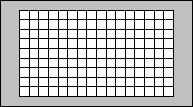

Standard Projector
4:3 ratio equals (1.33:1)
Widescreen Projector
16:9 ratio equals (1.78:1)
Anamorphic DVD
Why are Anamorphic DVDs better?
If you purchase DVD movies, then you probably enjoy collecting movies for the long term. You may not know, however, that some widescreen DVDs contain 33% more resolution than other widescreen DVDs. These DVDs with extra resolution are called "Anamorphic Widescreen", "Enhanced for Widescreen Projectors", or "Enhanced for 16:9 Projectors".
A Lesson in Aspect Ratio
TV's are sold in two different aspect ratios: Standard and Widescreen. There are widescreen televisions that are not high definition televisions. So you don't have to pay for an HD Projector to have a widescreen Projector.
 |
 |
|---|---|
Standard Projector 4:3 ratio equals (1.33:1) |
Widescreen Projector 16:9 ratio equals (1.78:1) |
Most broadcast TV programs and pre-1950's movies have an aspect ratio of 1.33:1 (read 1.33 to 1), so televisions in the past have always been made at this same 4:3 aspect ratio. But most widescreen movies have an aspect ratio of 1.85:1 or 2.35:1. To fill the entire screen of a 4:3 TV, the sides of a widescreen movie must be cropped off to make a "Pan&Scan" image. This reformatted image often loses characters and scenery essential to the movie presentation. To see the entire widescreen image as the movie director intended, the movie can be letterboxed to fit on a 4:3 TV. These are the black bars that appear above and below the movie frame. Widescreen Projectors minimize this letterboxing appearance and less of the Projector screen is wasted on the black bars because a widescreen Projector is closer to the aspect ratio of widescreen movies. In the near future of HD Projector broadcasting, widescreen Projectors will become the new standard.
Non-Anamorphic DVDs
Both the standard and widescreen TV have 480 lines of resolution counted from top to bottom. Consider a movie filmed at an aspect ratio of 1.85:1. A non-anamorphic DVD will letterbox the movie using only 345 lines of resolution for the movie image. The other 135 lines are wasted as black bars on the screen. A widescreen Projector can still magnify the letterbox image to fill most of the screen, but magnification does not increase the number of lines of resolution. What is more, magnification reveals gaps between the scan lines and defects in the video image.
 |
 |
|---|---|
 |
| Non-Anamorphic DVD on a 4:3 Projector | Non-Anamorphic DVD on a 16:9 display |
|---|---|
| Requires magnification to fill the screen |
Anamorphic - Why magnify when you can make the original image larger?
Anamorphic DVDs allocate more horizontal lines to the movie image. For the same 1.85:1 movie, an anamorphic DVD uses 462 lines of resolution. Only 18 lines are wasted on black bars. If a DVD player is set to 16:9 mode, but viewed on a 4:3 Projector, an anamorphic movie will appear stretched vertically due to the extra horizontal lines present in the image. But if the movie is viewed on a 16:9 widescreen Projector, the Projector automatically stretches the image horizontally back to the correct aspect ratio.
 |
 |
|
|---|---|---|
| Anamorphic DVD on a 4:3 Projector with the player set to 16:9 mode | Anamorphic DVD on a 16:9 Display No magnification required |
Some 4:3 Projectors can vertically compress the scan lines into a 16:9 sub-frame to display the image at the correct aspect ratio. If your 4:3 Projector does not support this feature, you can still view an anamorphic DVD at the correct aspect ratio. All DVD players have a playback mode called "4:3 Letterbox" which removes every 4th line of resolution from anamorphic DVDs. The converted image will look like a non-anamorphic, letterboxed DVD on a 4:3 Projector. Sony and Pioneer players perform the best conversion. So if you still have a 4:3 Projector without a 16:9 mode, you cannot utilize the extra resolution of an anamorphic DVD. But an anamorphic DVD still insures better image quality for movies older than 2-3 years because the studio must make a new video transfer of the movie to make an anamorphic DVD. In the near future, if you decide to upgrade to a widescreen Projector, you will be glad to have the anamorphic resolution in your collection. You will wish that all your non-anamorphic DVDs had been released as anamorphic.
How do you tell if a DVD is anamorphic?
Most anamorphic DVDs are labeled as "Anamorphic Widescreen" or "Enhanced for Widescreen TVs". If the disc package is not labeled, then you can often rely on the past releases of movie studios:
Columbia/Tristar almost always releases anamorphics (But they are never labeled)
Universal Home Video and Warner Home Video (WB) mostly release anamorphics
Paramount sometimes releases anamorphics
Fox has only released the Alien movies as anamorphic (Director, Ridley Scott, requested it)
Buena Vista (Disney) and Miramax have not released any anamorphic DVDs